Introduction
Note - This is a very old post!! Republishing it because i accidentally archived it
Farcaster is a sufficiently decentralized web3 social protocol on Ethereum. It aims to be a social network on top of which different clients with different structures can be built making it harder for users to get censored and giving users the ability to choose a client that best serves a user's need.
Recently, there has been an ongoing discussion regarding farcaster's growing total users and stagnant active users. So, in this post, Farcaster will be deeply analyzed using the certain growth metrics such as the reach,retention,revenue method described here and another similar approach described here
Approaches similar to the second approach(designed by the Tribe capital) were used by many companies in the early social media days (hence these metrics are perfectly suitable for analyzing Farcaster)-
These frameworks were largely independently derived across a variety of companies in the early days of the social web. Folks at social gaming companies (think Zynga, Slide, LOLApps, etc) as well as at the networks themselves (i.e. Facebook, Twitter, etc) all ended up measuring similar things with the aim of quantitatively tracking growth.
Caveats-
Farcaster has twice purged inactive accounts and their casts- once on 23rd September and once last month(this time inactive users got to keep their fids)
Last month, accounts that were inactive since February 2023 were purged.
As such data from before march 2023 isn't completely accurate as it impossible to find some of that data now. Data from September 2022 or before is included but it should be noted that there was a 40% reduction in users
The max fid at the end of September was - 2469. Assuming 40% attrition(source) - the total users before the September purge must've been around 4115.
With those caveats in mind, let's look at some data starting with the basics
Reach
A project's reach is helpful in understanding where the growth comes from and how the project is doing. In this analysis, casting is taken as a sign of a user's activity. Likes and recasts do not count.
Let's look at some metrics
Daily active users
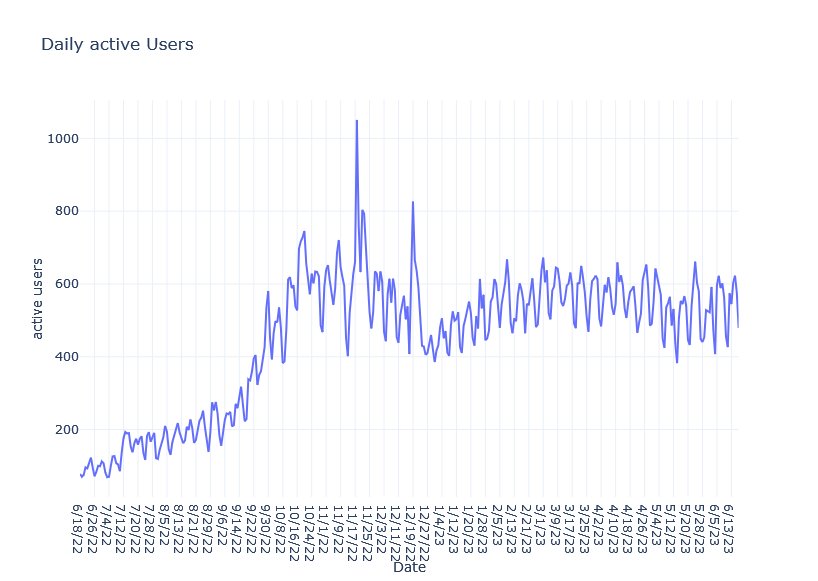
Insights
The number of Daily Active users on Farcaster sits around 500-600.
There were heavy spikes in the months on November and December.
The december spike can be attributed to people leaving twitter when Elon Musk banned links to other social media websites.
Monthly Active Users
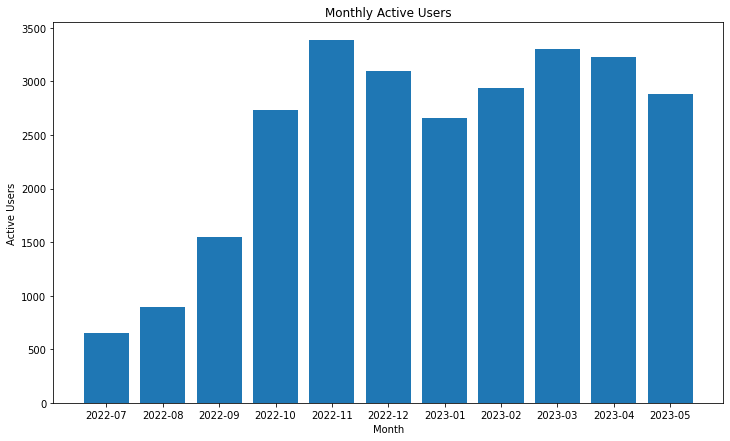
Insights
Monthly active users had rapid increase between August 2022 and November 2022.
The increase in the number of MAUs in October can be attributed to Farcaster protocol moving to the Goerli testnet in late September and giving users the ability to invite others. A similar increase in users will most likely also be seen when Farcaster moves to mainnet later this year.
The number of MAUs peaked in november 2022 have been somewhat stagnant since then - ranging between 3000 and 3500.
Weekly New Users
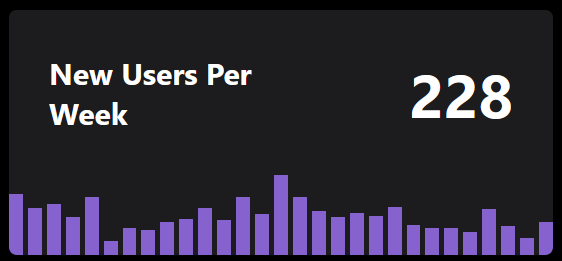
Total Number of Casts per month
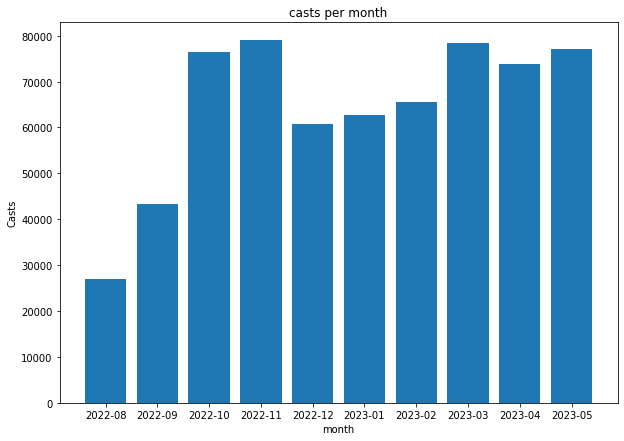
Insights
Similar to Monthly Active Users, Total Monthly casts also had a peak in November touching 80,000 casts in month and have been somewhat stagnant in growth since then.
Total users on Farcaster over time
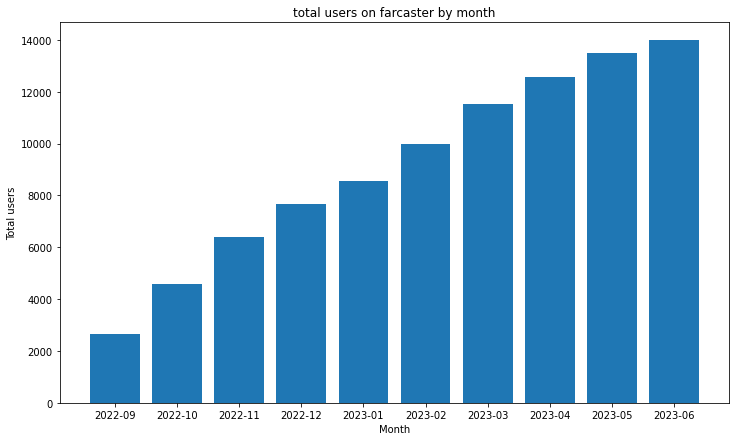
Insights
This metric was calculated using fids.
There was a rapid increase in total number of users in the months of October, November and December. Growth has slightly slowed down since then.
More Growth Metrics
The Compound Monthly Growth rates are important metrics, they show us the speed at which a project is growing and the general trend of growth over a period of time.
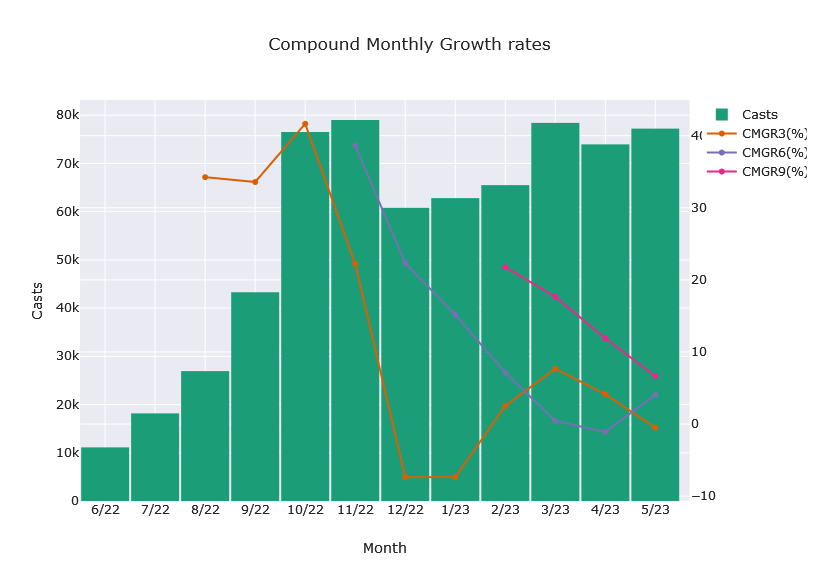
Key Insights
Farcaster had a very high Compound monthly growth rate till the month of October.
The number of casts kept growing since June 2022 till October 2022 when they hit 75k+ casts per month and hit 40+% of CMGR3 which is impressive.
CMGR3 has decreased since October 2022 and is currently sitting very near to 0 though very slightly negative(-0.5%)
CMGR6 is 4% in May 2023 while CMGR9 is 6.6%
So both GMGR6 and CMGR9 are still positive(due to being less sensitive to fluctuations) as of May 2023 though both are decreasing in value.
Please consider Subscribing if you like this analysis and would like to support me
Retention and Cohort Analysis
In MoM(Month on Month) retention analysis, we will be dividing users on the basis of when they first made their cast(as opposed to when they joined) ,i.e., if a user made their first cast in the month of January 2023 then they belong to the cohort of January 2023.
Few Restrictions -
Farcaster automatically deletes those casts that are older than 1 year(Source). So analyzing data older than 1 year is impractical. I have still included the data from June 2022 because Warpy(by pixel) and Warpcast api still seem to hold the data for those casts.
As mentioned in the Caveats earlier, around 1650 accounts were purged in september and around 3500 accounts were purged last month. So, the data from february or earlier is not completely free from inaccuracies.
Analysis -
user retention
Cohort month and cohort count
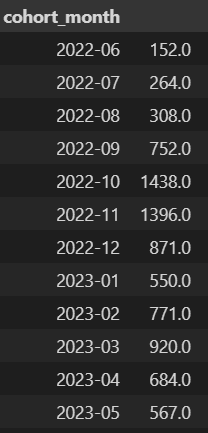
We can see that October 2022 has been the biggest cohort so far
Retention Rates
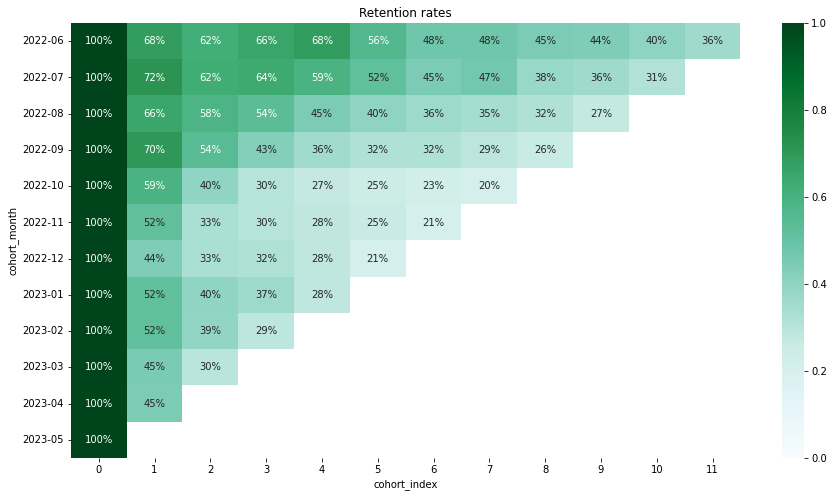
.
Retention Rate plotted
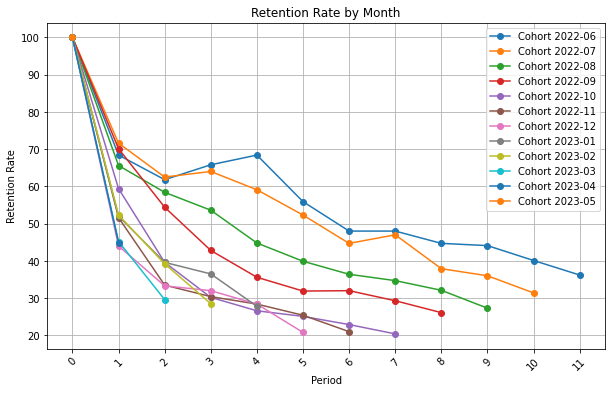
Insights
Older cohorts have a stronger retention rate than the newer ones but they also have a smaller size
Cohorts from June 2022 to September 2022 might have strong retentions because their cohorts have been purged twice
bigger cohorts like October and November 2022 have the weakest retention by the latest month
The cohort of December 2022 has the weakest retention(in the second month) despite having moderate size
Elon musk had banned links to any other social media in December 2022 as a result of which many people fled from twitter, the users who first casted in December might have been seeking an alternate twitter. December has the weakest retention(in 2nd month),this might mean that people who fled twitter didn't stick around
Cast retention
In cast retention analysis, the casts of users of a cohort are counted. The table below shows the cohort month to which the users belong and the number of casts these users made in their first month of casting.
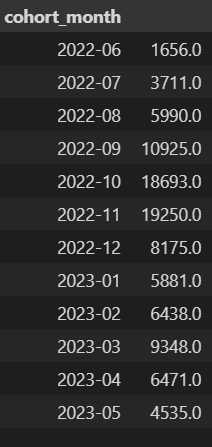
In the cast retention table, values can easily exceed 100% because a cohort might cast more in the later months than they did in their first month(i.e. their cohort month)
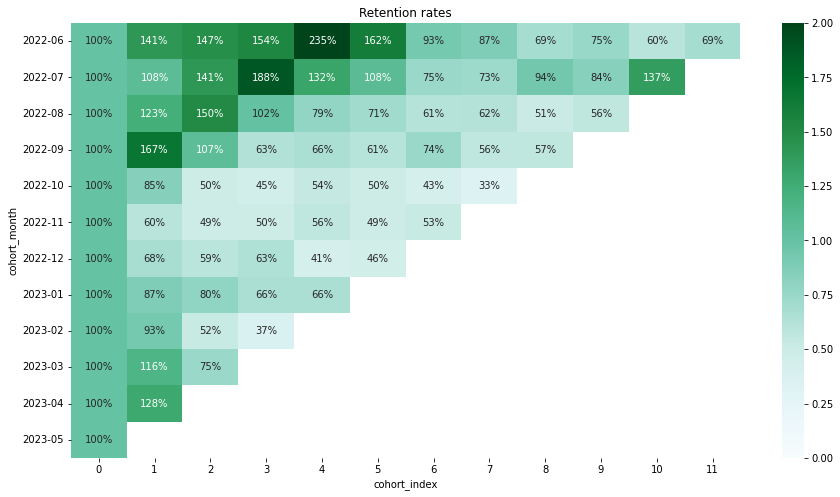
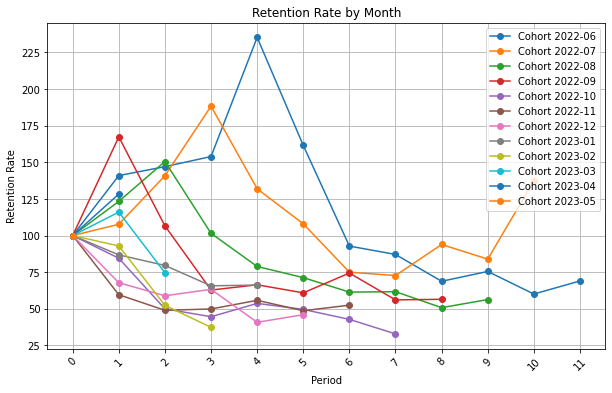
Insights
The casters from cohorts June 2022 to September 2022 had very high casts retention rate in the month of October.
The cohort of June 2022 had retention rate of 235% in the month of October
There could be two reasons for this high retention rate in october-
The people casting are the ones that survived the purge so they were talking about the purge
Farcaster moved goerli testnet which increased the overall activity on farcaster and farcaster also received many new casters which increased the general engagement.
The Cohort of July 2022 had an abnormally high cast retention in the month of May 2023
The recent cohorts(March and April 2023) had an increased retention in their next month, this is very promising and shows that retention of users might actually be slowly increasing.
The cohort of October 2022 had the worst retention rate in the month of May 2023
Lifetime value
Lifetime value is simply the total number of casts made by the users of a particular cohort over a period of time. Let's look at the data-
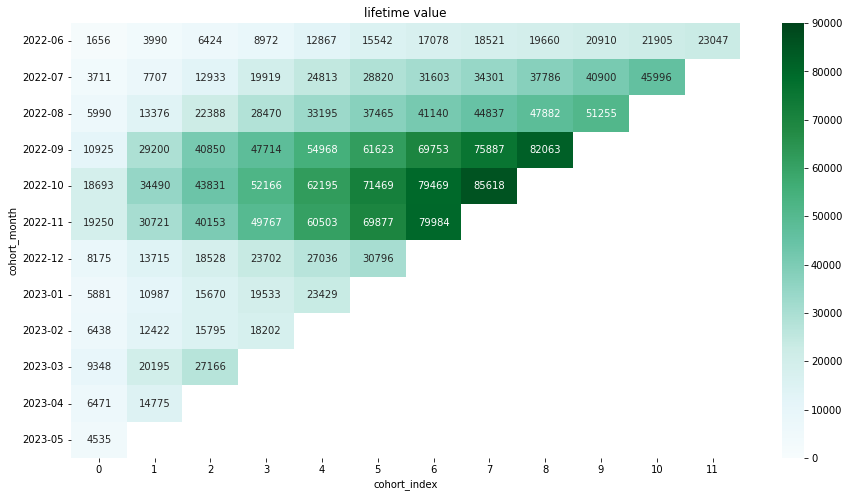
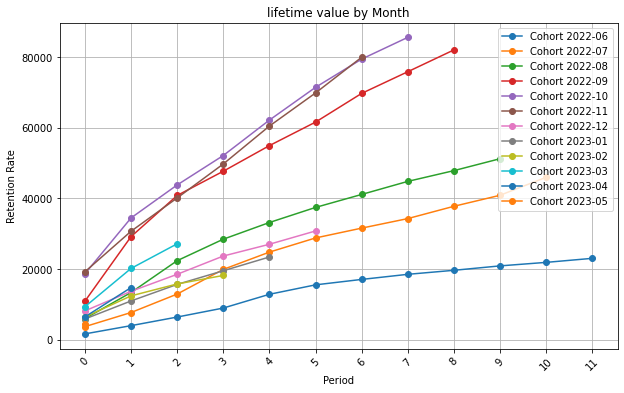
Insights
The Lifetime value metrics paints a different picture than cast or user retention metrics.
Although the cohort of October 2022 had the weakest retention in terms of users and casts, it still has the highest lifetime value of all cohorts.
The lifetime value of October 2022 cohort is also increasing at a higher rate than any other cohort
This is due to the fact that October 2022 had the biggest cohort size so despite having the weakest retention it still has highest Lifetime value
Same is applicable for November 2022 cohort which had a big cohort size hence a big lifetime value
In 2023, the cohort of march has the highest Lifetime value. The March 2023 cohort is generally very valuable in all metrics so far.
stickiness ratio(DAU/MAU)
Stickiness Ratio is calculated by simply dividing the average number of DAUs in a month by the total number of active users in a Month.
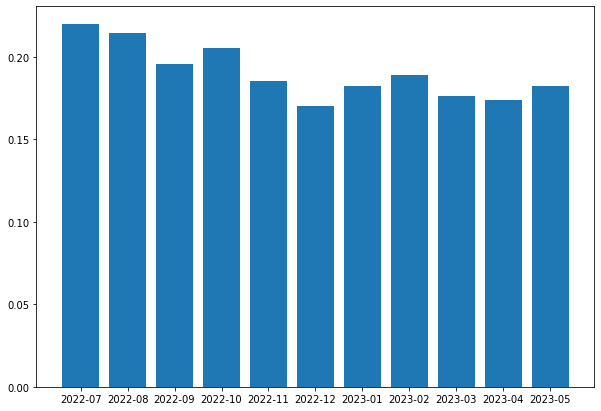
Insights -
The stickiness ratio has slightly gone down from 21.9% in July 2022 to 18.2% in May 2023, this means that most people don't cast for a lot of days in a month
This is further verified by the next chart -
Other Metrics
This data is from the month of May 2023. In this graph, we're looking at the looking at percentage of users that were active for 1 day,2 days, 3 days and so..
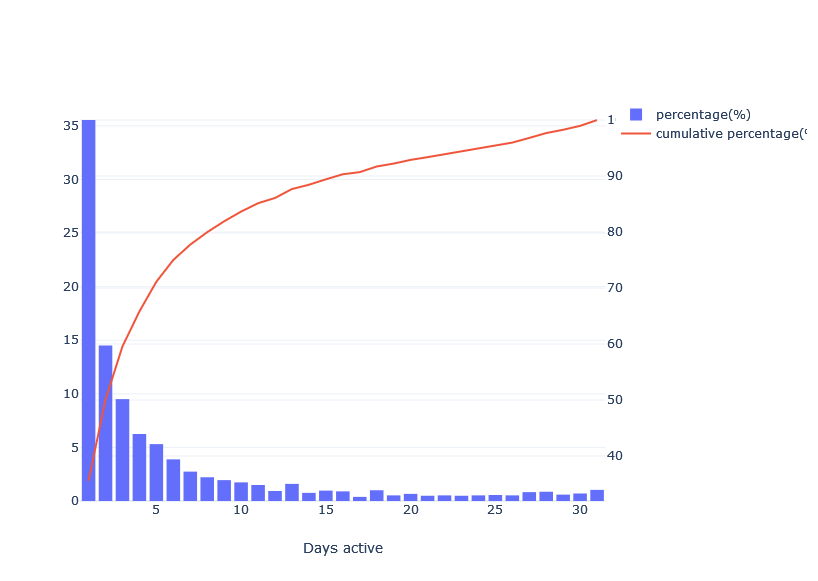
Insights
As we can see, about 35% percent of the users only casted 1 day in the whole month
followed by almost 15% percent of the user who casted only 2 days.
Note - This doesn't mean that most people are only using farcaster for 1 or 2 days. This simply means that most people only cast for about one or two days in a month even if use farcaster to view or react to casts.
Extra Metric - Dwr vs other inviters
Other users can also invite people to Farcaster but other users simply do not the same incentives as Dwr to invite sticky users. As such dwr claims that his invitees have a higher retention.
Of all the active users, 675 active users have shown who invited them. And out of almost 14000 users, 6240 people have shown their inviters. So these people will be considered for this analysis.
Note that this metric is quite different than the leaderboard that is available on warpcast. It takes people with active badges into account. active badges are given to those users who have a good reactions-to-cast ratio i.e. their casts get decent reactions. Looking at this metric can help us analyse who brought sticky and somewhat popular casters to Farcaster.
Let's look at the top 15 inviters
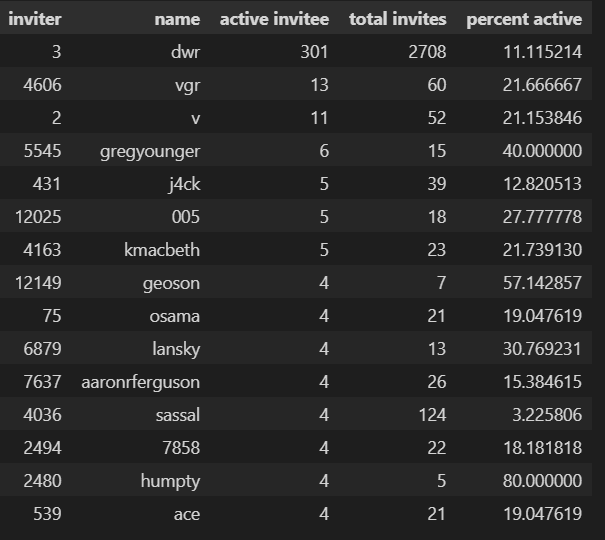
Insights
Dwr is obviously the top inviter with 301 active invitees
The person with the highest percent of active invitees among the top 15 inviters is humpty
There are many other casters who have a higher percent of active invitees than dwr
Conclusion
Here are some of the main insights from this analysis -
The number of Daily Active users on Farcaster sits around 500-600
The number of MAUs peaked in November 2022 have been somewhat stagnant since then - ranging between 3000 and 3500.
The cohort of October 2022 had the worst retention rate in the month of May 2023
Although the cohort of October 2022 had the weakest retention in terms of users and casts, it still has the highest lifetime value of all cohorts
Although the cohort of October 2022 had the weakest retention in terms of users and casts, it still has the highest lifetime value of all cohorts.
The stickiness ratio has slightly gone down from 21.9% in July 2022 to 18.2% in May 2023
If you enjoyed this report, please consider collecting this post. It will greatly help me make more reports. Those who collect this post might get access to locked content in the future reports(can't promise this because I am still experimenting)
You can tip me on my eth address as well.
Personal opinions and thoughts
I believe that Farcaster is a great web3 social protocol and I am confident in its future, though it does have a few issues one of them being there being only huge circle which is great if you're interested in networking with that group but not so great if you're not interested in networking with that group.
I am personally very excited about the introduction of channels, i think this will allow for more than one group to exist on farcaster which should definitely help farcaster grow.
I also like the recent proposal of paying for more storage.
I believe that Farcaster is working in the right direction and I would love to do more analysis on it as greater quantity and quality of data on Farcaster accumulates.
Acknowledgement
Thanks to searchcaster.xyz for helping me quickly search through different casts
Thanks farcaster.network for providing those very cool metrics
Also thanks to Pixel for making querying the data easier and for reminding me about the purged users.
DM me for any query or criticisms -
t.me/datayesyes
